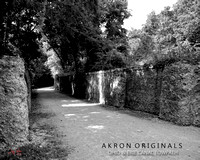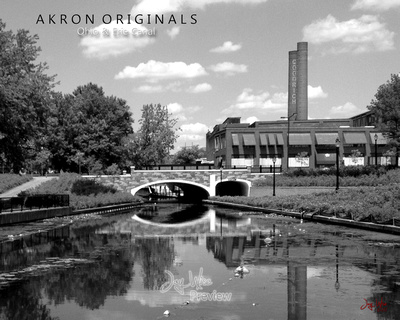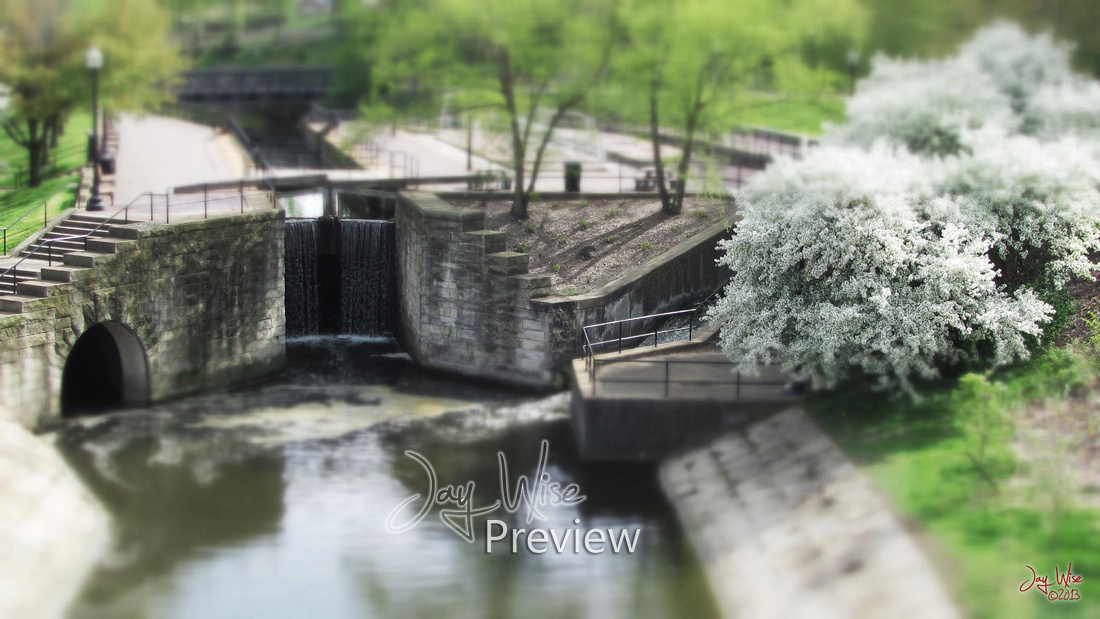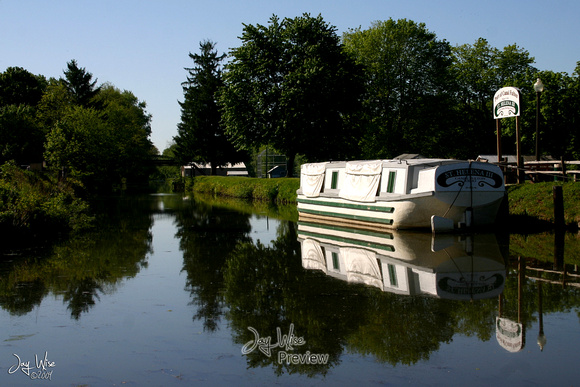A Canal Runs Through It


When people think of Akron, they often think Goodyear. The company with iconic blimp at sporting events calls Akron their world headquarters. But Akron's emergence goes well before that. Those who know their Akron history might next point to Quaker Oats, and the cereal empire built by Ferdinand Schumacher in the town. But you have to go well before that to know why Akron became a place to be.
In 1825 ground was broken around the state to build the first superhighway in the nation: canals. The Ohio & Erie Canal was set to connect Lake Erie at Cleveland with Portsmouth on the Ohio River, thus providing a crucial link between the Great Lakes and the Mississippi River and Gulf of Mexico. But it was the 30-some locks that led to the city at the summit of (then) Portage County that created the city known today as Akron.

 Locks, the waterway "elevators" to maintain a canal with no current where the elevation changes, were slow to navigate and those boats moving from Cleveland south would endure a slow journey through Akron. From Peninsula, Ohio, to Akron were 29 locks, many in rapid succession. Akron allowed the chance for the traveler or canawler (those working the canals) to visit a general store, grab a bit to eat or sleep overnight in a bed where no animals were close by (canal boats often had a back-up mule team on the canal boat for continual operation of the boat).
Locks, the waterway "elevators" to maintain a canal with no current where the elevation changes, were slow to navigate and those boats moving from Cleveland south would endure a slow journey through Akron. From Peninsula, Ohio, to Akron were 29 locks, many in rapid succession. Akron allowed the chance for the traveler or canawler (those working the canals) to visit a general store, grab a bit to eat or sleep overnight in a bed where no animals were close by (canal boats often had a back-up mule team on the canal boat for continual operation of the boat).
The Canal Era was short-lived, as the railroad quickly outpaced the canal boats in speed and capacity. But Ohio's canals continued to operate through 1913, when epic flooding throughout the state caused damage too significant to justify repairing and rebuilding. In Akron, pressure on the canal system with the rain and growing flood waters led to the intentional blasting of Lock 1.


Today the canal offers many different opportunities for people of all different persuasions. North of Akron the canal towpath wanders through the Cuyahoga Valley National Park, one of the nation's most locally accessed parks. Various coalitions and civic groups have combined to offer hiking and biking for over 100 miles of the towpath through Northeast Ohio. A biker with a strong set of legs and a day to wander, can ride from downtown Cleveland south to Zoar Village in Tuscarawas County and back.

 Along the way there is an operational lock at Rockside Road, south of Cleveland and the remnants of many locks through Peninsula just north of Akron. The Cuyahoga Valley Scenic Rail offers riders in the summer a chance to bike one way on the towpath and return on the train for just a few dollars. Along the stretch between Peninsula and Cleveland one can pass a Heron rookery and even an eagle's nest.
Along the way there is an operational lock at Rockside Road, south of Cleveland and the remnants of many locks through Peninsula just north of Akron. The Cuyahoga Valley Scenic Rail offers riders in the summer a chance to bike one way on the towpath and return on the train for just a few dollars. Along the stretch between Peninsula and Cleveland one can pass a Heron rookery and even an eagle's nest.
The towpath uniquely winds through downtown Akron, where Lock 3 has been turned into a recreation and entertainment complex. To the north, the canal winds under the Civic Theater (yes, under!) and restored Mustills General Store anchors the northern end of the downtown area in the Cascade Locks section. Heading south from Lock 3, the Cleveland Indians AA farm team, the Akron Aeros, play at appropriately named Canal Park, located at Lock 2. A memorial park with a metal skeleton of a canal packet boat sits atop the lock just beyond the center field wall of the stadium.


From Akron's Lock 1, the numbering goes up in either direction. Heading south to Canal Fulton, history buffs can board the St. Helena III and take a one mile ride along the canal to Lock 4. The Tuscarawas River, which feeds the canal throughout Summit and Stark counties, offers canoeing adventures that include "pedal and paddle" where you can bike one way and canoe the other.

 Those venturing farther south can jump off the towpath at Zoar Village and step back hundreds of years to a communal village that has been restored and offers self-guided and guided tours of many of the historic homes within the village. The hundred-plus miles of towpath today are well maintained, with crushed limestone offering good footing (and biking) for much of the trail. Continual improvements offer better conditions in many spots.
Those venturing farther south can jump off the towpath at Zoar Village and step back hundreds of years to a communal village that has been restored and offers self-guided and guided tours of many of the historic homes within the village. The hundred-plus miles of towpath today are well maintained, with crushed limestone offering good footing (and biking) for much of the trail. Continual improvements offer better conditions in many spots.
Ohio's Canal legacy runs deep, even though the canals themselves were but four feet deep and lasted less than 100 years. There's much to see and enjoy on Ohio's first economic superhighway.
- J.